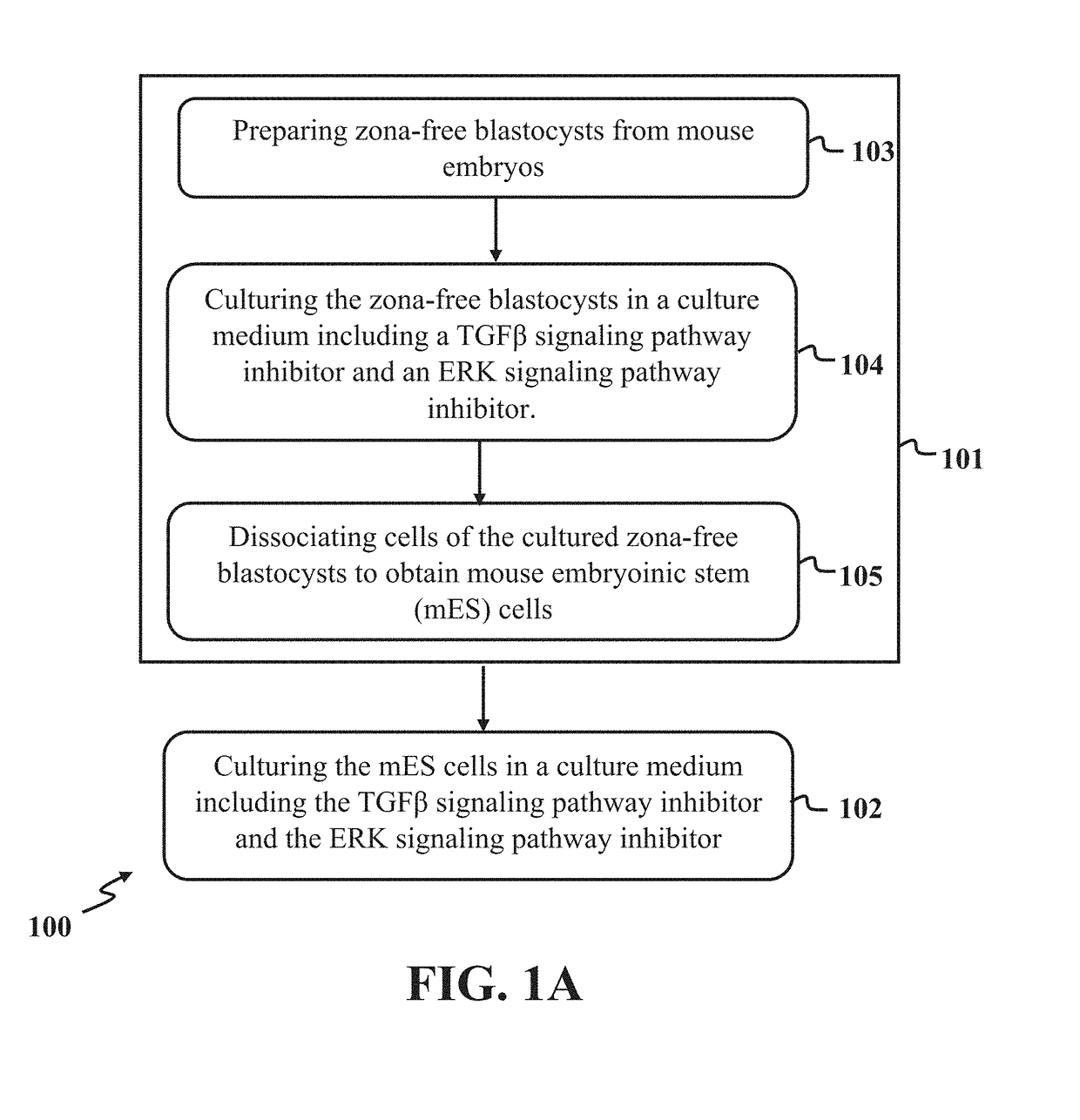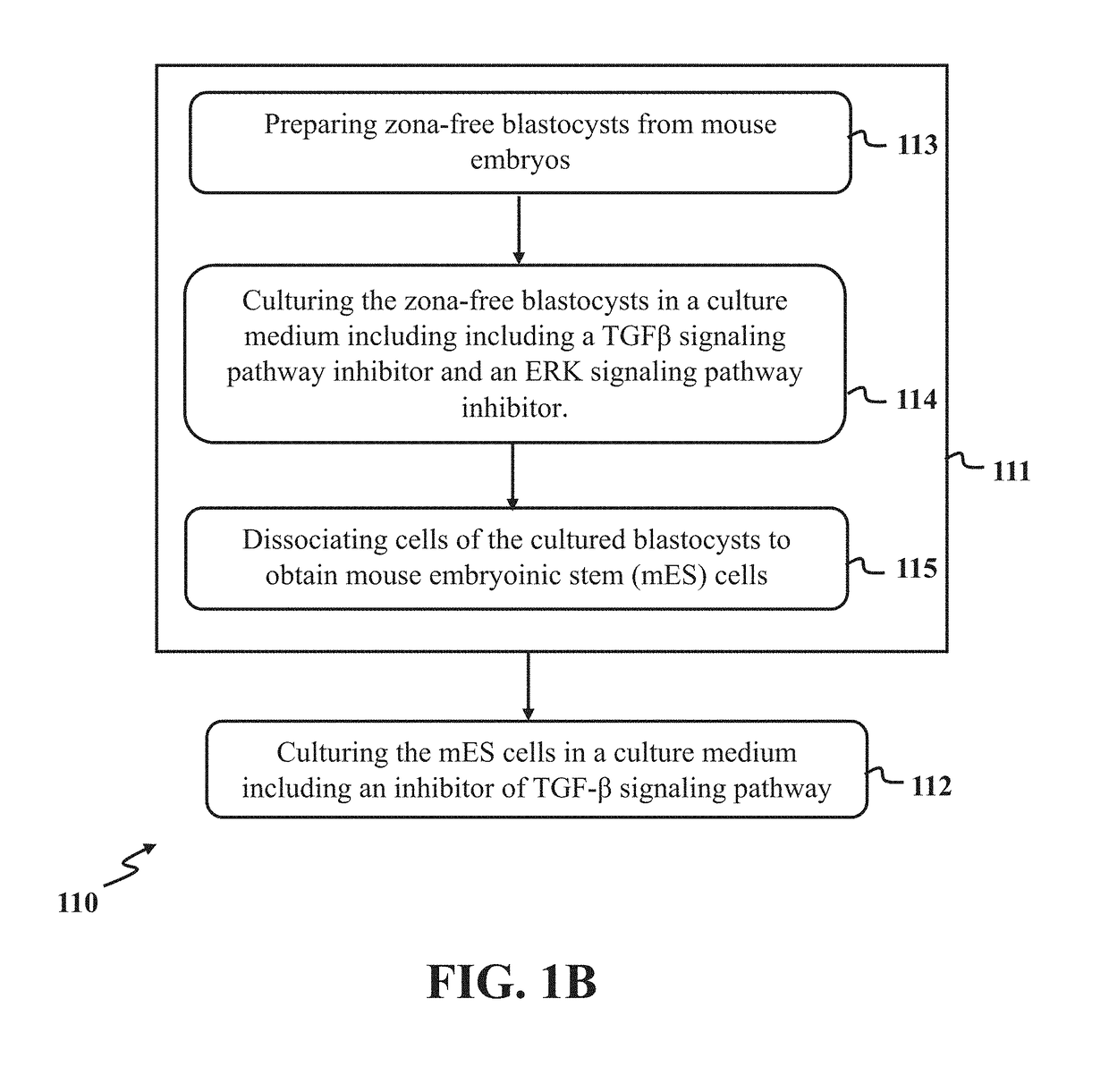Establishing pluripotency in mouse embryonic stem cells
a pluripotency technology, applied in the field of mouse embryonic stem cell derivation and maintenance, can solve the problems of -term maintenance and the inability to support the derivation of embryonic stem cells from most mouse strains, and achieve the effect of ensuring the survival of embryonic stem cells and identifying optimal cell culture conditions
- Summary
- Abstract
- Description
- Claims
- Application Information
AI Technical Summary
Benefits of technology
Problems solved by technology
Method used
Image
Examples
example 1
ing Pluripotency in Mouse Embryonic Stem Cells from Blastocysts
[0054]In EXAMPLE 1, pluripotency was established in mouse embryonic stem (mES) cells. Mice from different strains were maintained on a 12-hour light / dark regimen. The mice were superovulated with a standard protocol, and embryos with 2, 4, and 8 cells were captured 44, 54, and 68 hours after injecting human chorionic gonadotropin (hCG) hormone to Fla, DBA / 2, and BALB / c mouse strains. The mouse embryos were recovered by flushing uteri for collecting the blastocysts or by flushing oviduct for early cleavage embryos.
[0055]Derivation of mES cells at a blastocyst stage was accomplished by plating zona-free 3.5-day blastocysts on gelatin-coated plates including N2B27 medium with and without leukemia inhibitory factor (LIF) and supplemented with the R2i compound. The R2i compound was a combination of 1 μM of PD0325901 and 10 μM of SB431542.
[0056]Five to seven days after blastocysts plating, the cells were dissociated using a tr...
example 2
ing Pluripotency in Mouse Embryonic Stem Cells Using Single Blastomeres
[0063]In EXAMPLE 2, the effect of the R2i compound on the derivation and maintenance of pluripotency in mES cell from single blastomeres was investigated. The R2i compound increases the development of embryonic cleavage and clonally propagation of mES cells from single blastomeres. In order to investigate the possibility that the R2i compound attains naive pluripotency from early cleavage stage mouse embryos, the mouse embryonic stem (mES) cells derivation from single blastomeres at different developmental stages was analyzed.
[0064]In an initial step, in order to exclude the probability that N2B27 basal medium induces a destructive effect on the embryonic cleavage, the embryo development of NMRI mouse strain from 2-cell stage towards intact hatched blastocyst in the droplets of different media was analyzed.
[0065]The media used included KSOM (potassium-supplemented simplex optimised medium) as a conventional cleav...
example 3
ing Pluripotency in Mouse Embryonic Stem Cells Using ICM Cells
[0080]In EXAMPLE 3, the effect of the R2i compound on the derivation and maintenance of pluripotency in mES cell using inner cell mass (ICM) cells was investigated. Several zona-free 3.5-day blastocysts of C57BL / 6 (Oct4APE: GFP+ or OG2)×CD-I mouse strain were initially cultured on gelatin-coated 96-well plates containing N2B27 medium supplemented with the R2i compound (as test groups) and on gelatin-coated 96-well plates containing N2B27 medium supplemented with FBS serum and LIF (as control groups).
[0081]In the presence of the R2i compound, ICM cells were propagated while maintaining Oct4 expression after 6 days and few trophectodermal cells surrounded the ICM cells. In contrast, in the presence of FBS, regardless of significant ICM outgrowth, the GFP expression decreased over time and disappeared by the 6th day. In this condition, numerous trophectodermal and differentiated cells surrounded the outgrowth of ICM cells.
[0...
PUM
| Property | Measurement | Unit |
|---|---|---|
| time | aaaaa | aaaaa |
| time | aaaaa | aaaaa |
| time | aaaaa | aaaaa |
Abstract
Description
Claims
Application Information
 Login to View More
Login to View More - R&D
- Intellectual Property
- Life Sciences
- Materials
- Tech Scout
- Unparalleled Data Quality
- Higher Quality Content
- 60% Fewer Hallucinations
Browse by: Latest US Patents, China's latest patents, Technical Efficacy Thesaurus, Application Domain, Technology Topic, Popular Technical Reports.
© 2025 PatSnap. All rights reserved.Legal|Privacy policy|Modern Slavery Act Transparency Statement|Sitemap|About US| Contact US: help@patsnap.com



